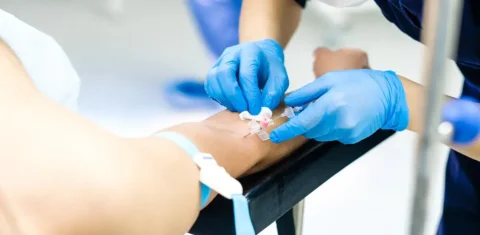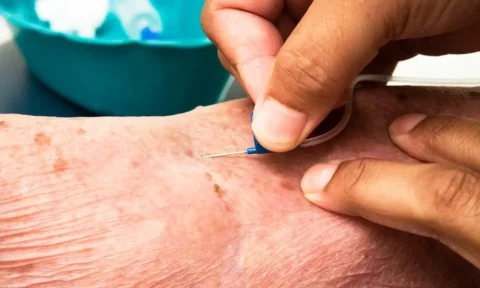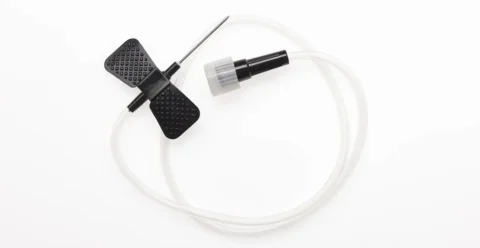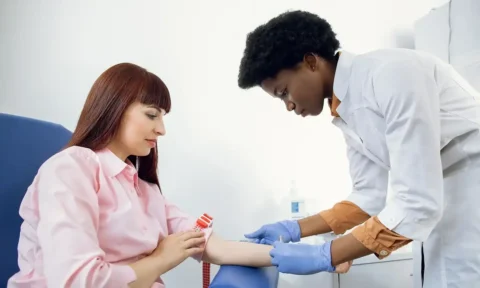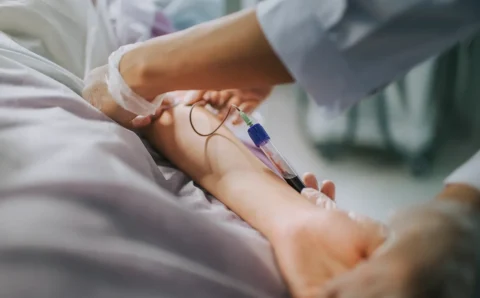Blood collection, also known as venipuncture or phlebotomy, is a common but important medical procedure that allows healthcare professionals to perform a proper diagnosis. But do note that this process may cause anxiety and discomfort for a patient, which is why the blood sampling method is one of the most important things to consider before collecting blood.
So what is the common method for drawing and collecting blood between a syringe, vacuum tube, and butterfly needle? These needle types have their own advantages and disadvantages, but straight-needle syringes are most commonly used during blood collection. However, the healthcare professional may also use a butterfly needle or vacuum tube as necessary.
Choosing the Right Needle for Venipuncture: Syringe, Vacuum Tube, or Butterfly Needle
Everyone has most likely already had their blood sample taken at some point in their life for a blood test or blood donation. A routine venipuncture procedure is a common medical process, but it remains to be the subject of dislike, pain, and anxiety for most patients.
One of the ways to put a patient at ease during a blood draw is to use smaller needles and apply less pressure when inserting the needle. A phlebotomist may use a straight needle or butterfly needle during the process.
But regardless of the type of tool they use, they should still perform each venipuncture procedure using the right specimen collection technique to avoid any injection site complication or test result contamination.
What Venipuncture Is and Why It’s Needed
Blood is essential because it helps move nutrients, oxygen, waste products, and other materials to different parts of the body. It’s made up of two parts: the blood cells and the plasma. The cells refer to the red blood cells, white blood cells, and platelets while the plasma is the liquid part of the blood that contains water, proteins, glucose, and electrolytes.
Venipuncture or phlebotomy is a medical process that involves drawing blood samples from the patient for different clinical laboratory tests. Most of the time, the blood sample is collected through a needle insertion in the inner part of the forearm where several large veins (such as the antecubital vein, basilic vein, median cubital vein, cephalic vein, and median cephalic vein) are found.
Testing the blood or some parts of it gives the healthcare professional important clues about your health. Because of its importance and applications in the medical field, healthcare professionals should know the right way to perform venipuncture and how to calm their patients during the process.
Depending on the patient’s pain tolerance and the type of blood test to be performed, healthcare providers may use different kinds of needles and collection systems such as the following.
a. Using a Syringe
Using a hypodermic needle and syringe for blood collection is a type of closed-system venipuncture. It’s a common method that’s proven safer than open-system blood collections.
Appearance
A straight needle is attached to a syringe before the blood collection starts. The syringe is a simple reciprocating pump that consists of a cylindrical collection tube (that holds the blood sample) and a plunger (that the healthcare professional pulls to draw blood in).
The hypodermic needle connected to the syringe usually comes in different sizes, but the recommended needle size for adult patients is 21-gauge. The healthcare professional may also use a 22-gauge needle for younger patients or adult patients with smaller veins.
Common Uses
- Administering injections
- Infusing IV therapy into the bloodstream
- Drawing and measuring liquids
Advantages
- Leads to quick and easy blood collection
- Allows accurate blood collection volume
- Results in relatively constant blood flow rate into the syringe
Disadvantages
- Limits the amount of blood to be drawn from the patient
- May lead to pressure buildup and eventual syringe pump failure
b. Using a Vacuum Tube
Vacuum tube extraction systems are also closed systems of blood collection, so they’re known for reducing the risk of direct exposure to blood samples. This type of collection method also allows multiple blood sample collection using a single puncture site.
Appearance
The vacuum tube collection system consists of a needle, barrel, and multiple blood collection tubes with different colored tops. This system also uses double-ended needles of different sizes with one end covered by a rubber cuff and screwed into the barrel.
A thread separates the two ends of the needle, in which the barrel is also screwed into place. The blood sample tube is under vacuum so that the blood is automatically drawn until the required amount has been collected.
Common Uses
- Collecting blood samples for blood culture and other tests
- During blood donation drives (using a vacutainer needle)
Advantages
- Prevents user contact with the blood to avoid infection
- Prevents blood samples from getting contaminated
- Has an accurate scale that allows precise extraction
Disadvantages
- Vacuum pressure may collapse or injure the patient’s vein
- Users have to be extremely careful to avoid dislodging the needle when changing collection tubes
c. Using a Butterfly Needle
Butterfly needles or winged steel needles are open systems of blood collection. Aside from drawing blood from the patient, they’re also useful for delivering most types of laboratory medicine or other liquids to the vein through an intravenous catheter.
Appearance
Butterfly needles are also known as the scalp vein set or winged infusion set. This medical equipment got its name from the plastic wings on either side of the hollow needle, giving healthcare professionals better access to the vein.
Some parts of the butterfly needle may be different depending on the manufacturer, but most of them have a needle in a plastic covering. The needle is then attached to tubing that may have a Luer lock, a type of connection that users can twist a syringe on.
The needle size of butterfly needles ranges from 18-gauge to 27-gauge while the length of the tubes ranges from 8 inches to 15 inches.
Common Uses
- Collecting blood samples for medical tests
- Administering medications using an IV catheter line
- Performing IV hydration therapies
Advantages
- Easy access to superficial veins, thanks to the shallow-angle design
- Less threatening and painful for most patients
- Better access to small and narrow veins of infants or elder patients
- Can be used for the tiny veins in the scalp, heel, foot, and hand
- Less likely to cause nerve injury, vein collapse, or profuse bleeding
Disadvantages
- Slower blood collection
- Not recommended for squeamish patients or urgent situations
- May damage the vein if the butterfly needle is suddenly yanked
- Best used for IV infusion therapies that only take 5 hours or less
How to Draw Blood: A Step-by-Step Guide
Drawing blood is an important medical process, but it can also be a daunting one for both patients and medical practitioners. To perform venipuncture correctly, here are important steps to follow:
1. Preparing the Supplies
Before starting phlebotomy, it’s important to have all the needed supplies at hand first. Some medical professionals have all their blood collection supplies in one kit while others need to acquire each item individually. When gathering the supplies, make sure to take a few extra items in case you need to perform a second venipuncture.
Some of the supplies to prepare are:
- Blood drawing system to use (syringe, vacuum tube, or butterfly needle set)
- An evacuated tube that’s specific to the laboratory test ordered
- Tourniquet
- Personal protective equipment (like gloves)
- Alcohol swabs
- Blood specimen labels
- Leak-proof transportation bags
- Gauze
- Hand sanitizer
- Blood transfer device
- Puncture-resistant container for sharp objects
2. Identifying and Preparing the Injection Site
- Inspect the area first to find a suitable vein.
- Apply the tourniquet then have the patients make a fist. Using your index finger, try to locate a large-diameter vein that has good turgidity.
- Locate the veins better by tapping the potential injection site with your fingers. You may also ask the patient to hang their hand down to increase vein pressure.
- After finding the best injection or cannulation site, remove the tourniquet.
- Cleanse the skin of the treatment area with an antiseptic solution. Start at the needle puncture site and make several outwardly expanding circles.
- Wait for the antiseptic solution to dry.
- When collecting blood samples for blood culture: Vigorously cleanse the site with alcohol for about 30 seconds. Swab it outwardly in circles, overlapping with povidone iodine or chlorhexidine. Wait for the antiseptic effect to show then wipe off the povidone iodine with alcohol and allow it to dry. Don’t touch the injection site with non-sterile items.
3. Drawing the Blood
Specific blood collection systems have corresponding steps, so make sure to follow them. But for the most part, here’s what you need to do when drawing blood:
- Reapply the tourniquet near the injection site but don’t ask the patient to make a fist or hang their arm down.
- Locate the middle of the target vein with a gloved finger.
- Prevent the vein from moving by applying gentle traction to the vein distally using the non-dominant thumb. However, traction might not be needed for the antecubital fossa or other large veins.
- Insert the needle in the direction of the blood flow, along the midline of the target vein, and at a shallow angle of about 10° to 30°.
- If the needle is properly inserted, healthcare professionals find blood in the catheter (known as a blood flash). If this doesn’t happen, then the needle hasn’t punctured the vein or it went through the vein.
- Keep the needle motionless. Start withdrawing the blood sample and make sure that the blood flows through before removing the tourniquet.
a. Syringe Venipuncture Steps
- Gently pull the plunger back to slowly collect the blood. This is important to avoid hemolysis or vein collapse.
b. Vacuum Tube Venipuncture Steps
- Carefully push each of the tubes into the tube holder.
- Avoid dislodging the needle from the vein during the process.
- Fill all the needed collection tubes in proper sequence: blood culture tube first, then tubes with clot activator, and then others.
- After removing each tube from the holder, gently invert it about 6 to 8 times to mix the blood with the rest of the contents. Do not shake any of the tubes.
c. Butterfly Needle Venipuncture Steps
- Hold the butterfly needle by its wings between the index finger and thumb.
- Insert the thin needle toward a vein and at a shallow angle. A blood flash also occurs if the needle is inserted correctly.
- Gently stabilize the needle using its wings to prevent it from shifting or rolling.
4. Removing the Needle
- Have the gauze pad or tape ready in your other hand which isn’t holding the needle.
- Apply the gauze pad over the injection site but don’t apply pressure yet.
- Simultaneously withdraw the needle from the patient while putting the gauze pad over the puncture site. Make sure to activate the needle’s safety mechanism to avoid needlestick injury.
- Apply pressure over the injection site using the gauze pad until it stops bleeding.
- Check the state of the puncture site for about 5 to 10 seconds before applying a bandage or tape over it. Ask the patient to avoid bending the arm where their blood was drawn.
5. Finishing Up
- Discard the needle, syringe, and transfer the device into the sharps container. Don’t recap the needle or remove it from the collection barrel.
- Check the collection tubes for signs of external contamination. If necessary, make sure to decontaminate the blood collection tube according to the laboratory instructions.
- Label the specimen according to the institution’s policies. Healthcare professionals are usually asked to include the patient’s name, as well as the collection date and time.
- Reassess the injection site to see if a hematoma has formed or if the bleeding has stopped.
- Evaluate the patient’s pain and treat them if necessary.
- Remove your PPE and perform proper hand hygiene.
What to Do If Your Needle is Contaminated
Needles used for blood collection should always be sterile. They’re not meant to be reused, so make sure to discard the equipment properly after use. But in case the needle is contaminated, gently but swiftly remove it from the patient. Observe the injection site for any symptoms of infection. Redo the entire process but make sure to use sterile equipment this time.
As for external contamination of the blood collection tubes, each laboratory has its own decontamination practices. Make sure to follow them properly to prevent cross-contamination and reduce the risk of pathogen exposure in the blood samples.
Find the Best Blood Drawing Equipment at FACE Med Store
Blood collection is an important medical procedure that tells healthcare professionals a lot about the health condition of their patients. Aside from the medical provider’s skills, the quality of the blood drawing equipment is also important for a successful venipuncture.
For the best blood drawing equipment, you can find high-quality blood collection needles, vacutainer needles, butterfly needles, and more at FACE Med Store. We’re the trusted partner of hundreds of healthcare practitioners around the country when it comes to medical supplies, health products, and more.
Call us today to know more about our blood collection products and ask about the best deals for you.
